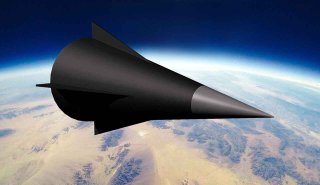While everyone was fixated on the stunning performance of Russia’s Su-57 “Felon” fifth-generation warplane and the surprise announcement of China’s new sixth-generation warplane the “White Emperor” at November’s Zhuhai Air Show in Guangdong Province, China, many overlooked another important announcement from the Chinese military.
They unveiled the GDF-600 hypersonic weapon that, according to Gabriel Honrada of the Asia Times, “could redefine warfare with its fast, multi-target strike and electronic attack capabilities, posing a serious challenge to Taiwan and US forces in the Pacific.”
The GDF-600 is apparently an unpowered hypersonic boost-glide weapon that was created by Guangdong Aerodynamics Research Academy (GARA). It will join China’s already impressive—and rapidly expanding—hypersonic weapons arsenal. These weapons are especially potent because there is no active defense against them.
What’s more, the United States lacks its own working arsenal of hypersonic weapons. The only nations that currently have large stocks of various hypersonic weapons include not only China, but Russia, along with North Korea and possibly Iran.
Indeed, while the Pentagon asserts that China’s hypersonic weapons are the most serious threat to the United States military, the Chinese arsenal is nowhere near as refined (in terms of practical applications) as the Russian arsenal.
China’s Latent Hypersonic Weapons Capacity
Where China has considerable advantages over the Russians, though, is in the fact that they are the second-largest economy in the world (in Gross Domestic Product, GDP, terms) and they have a tech sector that rivals even the United States. Plus, the fact that China is not actively engaged in a major war as Russia is, means that the Chinese have time to truly refine these dangerous systems.
And Beijing is doing just that. Because the GDF-600 isn’t even the most lethal of China’s expanding hypersonic weapons arsenal.
Anyway, the GDF-600 is particularly problematic in the context of a potential Chinese invasion of its neighboring island democracy of Taiwan. Chinese scientists have stated their new unpowered boost-glide hypersonic weapon can go as fast as Mach 7 while carrying a multitude of submunitions onboard—including drones, loitering munitions, and even supersonic missiles!
The US defense publication The War Zone assesses that the GDF-600s can “release these payloads mid-flight enhancing its operational versatility, allowing it to conduct kinetic strikes, electronic warfare (EW) and reconnaissance across multiple targets.”
The Americans, with their nearly $1 trillion defense budget have nothing approximating this capability. Already, the Americans have been humiliated by Vladimir Putin’s Russia when, after Washington authorized their Ukrainian proxies to fire American ATACMS into Russia, Moscow responded with launching their nuclear-capable Oreshnik (“Hazel,” in Russian) long-range hypersonic weapon at Dnipro. Washington pretended like the whole thing never happened.
But it did.
Not Noticing We’re On Notice
And it was the mother-of-all wake-up calls that no one in the Pentagon seems to have really gotten.
Looking at the GDF-600 system being developed by China, it’s even scarier than the Russian Oreshnik. That should be especially concerning, given the fact that it is obvious China’s President Xi Jinping has intentions to conquer Taiwan soon.
If these hypersonic weapons are ready for deployment in such a conflict, Taiwan will be rendered utterly defenseless. Taiwan already is at a disadvantage when it comes to resisting a Chinese invasion. With the GDF-600, if it works as advertised, China could deploy multiple warheads decimating key targets at once in Taiwan, using a weapon against which there are no active defenses. The EW capabilities of the GDF-600 would stymie whatever defenses the Taiwanese did try to deploy against this devastating hypersonic weapon.
Armed with this GDF-600 hypersonic weapon, China will eviscerate whatever defenses the Taiwanese have.
Brandon J. Weichert, a Senior National Security Editor at The National Interest as well as a Senior Fellow at the Center for the National Interest, and a contributor at Popular Mechanics, consults regularly with various government institutions and private organizations on geopolitical issues. Weichert’s writings have appeared in multiple publications, including the Washington Times, National Review, The American Spectator, MSN, the Asia Times, and countless others. His books include Winning Space: How America Remains a Superpower, Biohacked: China’s Race to Control Life, and The Shadow War: Iran’s Quest for Supremacy. His newest book, A Disaster of Our Own Making: How the West Lost Ukraine is available for purchase wherever books are sold. He can be followed via Twitter @WeTheBrandon.
Image: Wikimedia Commons.

